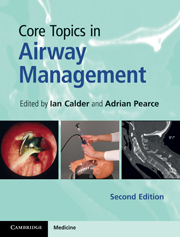Book contents
- Core Topics in Airway Management
- Core Topics in Airway Management
- Copyright page
- Contents
- Contributors
- Preface to the second edition – Calder and Pearce
- Section 1 Basic science
- Chapter 1 Anatomy
- Chapter 2 Physiology of apnoea and hypoxia
- Chapter 3 Physics and physiology
- Chapter 4 Airway reflexes
- Chapter 5 Decontamination of airway equipment
- Section 2 Clinical
- Section 3 Specialties
- Section 4 Ethics and the law
- Section 5 Examination questions
- Index
Chapter 2 - Physiology of apnoea and hypoxia
from Section 1 - Basic science
Published online by Cambridge University Press: 10 January 2011
- Core Topics in Airway Management
- Core Topics in Airway Management
- Copyright page
- Contents
- Contributors
- Preface to the second edition – Calder and Pearce
- Section 1 Basic science
- Chapter 1 Anatomy
- Chapter 2 Physiology of apnoea and hypoxia
- Chapter 3 Physics and physiology
- Chapter 4 Airway reflexes
- Chapter 5 Decontamination of airway equipment
- Section 2 Clinical
- Section 3 Specialties
- Section 4 Ethics and the law
- Section 5 Examination questions
- Index
Summary
- Type
- Chapter
- Information
- Core Topics in Airway Management , pp. 9 - 18Publisher: Cambridge University PressPrint publication year: 2010



